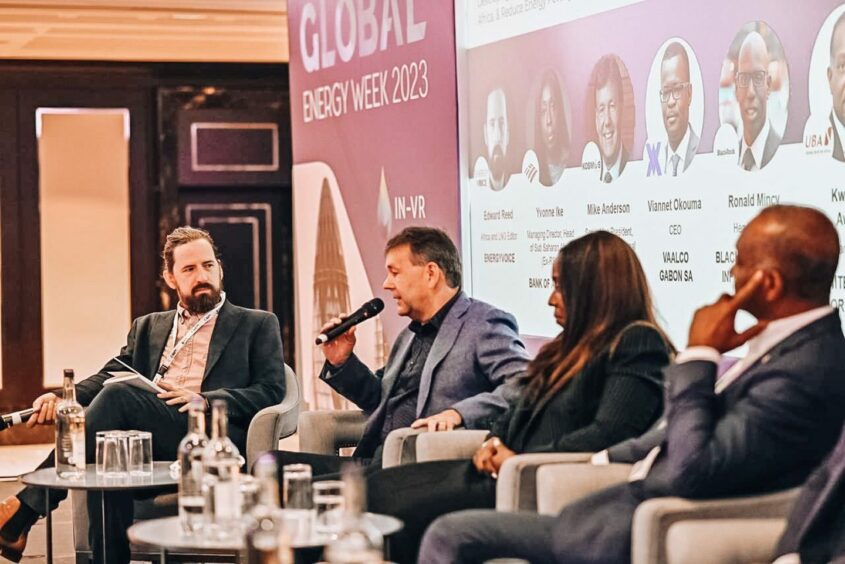
Financing Africa’s energy projects – whether using hydrocarbons or renewables – will require new ways of thinking, panellists said this week at the Global Energy Week.
As Europe has begun searching for new sources of its own fossil fuels, to compensate for its move away from Russia, thinking is evolving.
“European governments are struggling about the balance of fossil fuels and green – and no one’s got it right yet,” Kosmos Energy senior vice president Mike Anderson said. “It’s led to an ambivalence where they say, ‘yes, we want to help African countries’, but also ‘Oh no, they’re not allowed to do this, they’re not allowed to do that’.”
This is an “absurd way of running a financing system”, Anderson said. To meet Africa’s energy needs “you need the right financing answer and you need the right execution. And, by the way, you do need [oil and gas] companies like ours.”
United Bank for Africa chair Kweku Awotwi, and former Tullow Oil executive, noted the unique challenges in Africa’s energy.
“Access is the critical word and the second word is affordability, but perhaps the third is sustainability. There are creative solutions out there,” he said. There’s really a concern that funds for traditional oil and gas is contracting – and that’s a worry. My sense is that a lot of government officials have been kicking against and their voices have been heard.”
Culture shift
The Kosmos official went on to highlight the importance of COP28, due to take place in Dubai in November. Head of Adnoc, Sultan Al Jaber, has been appointed president delegate for the talks – to some consternation.
“I think it’s the perfect COP. Because it’s people who have capital now and are looking to green in the future. It can genuinely change how energy financing can be done for the next 20 years – but I’m sceptical that the global north will allow that to happen.”
The talks at COP28, Anderson said, provide a chance for a “cultural signal”, which would need to precede practical change.
“It’s transition on our own terms, with our own resources. We need to get smarter about how we articulate that, not as victims, or as people who need to be allowed to do things,” said Yvonne Ike, head of sub-Saharan Africa at Bank of America. “We need to work with the countries that get it, so from the Gulf, from Asia.”
Cost of funding
As mortgage payers will be all too aware, interest rates are going up, with the Fed reaching 5%. Higher interest rates, in addition to the risk premium in Africa, sees the cost of capital rising to around 15%.
A group of European countries and Canada recently approved Senegal to join the Just Energy Transition Partnership (JETP). “The point of JETP is supposed to be to bring the cost of capital down. Let’s see. I’ve not seen the money flooding into the system,” said Kosmos’ Anderson.
Ike cited an example where Bank of America had agreed to fund the Africa Finance Corp. (AFC), which in turn lent to the Egyptian government for an infrastructure project.
Her bank would not have had the “time or perhaps the imagination to understand this as robustly. Global institutions need to leverage local institutions to deploy more capital,” she said. “Blended finance is another big initiative.”
The critical step is to demystify the “larger conversation and bring it down to real issues and articulate each of those initiatives at a local level”.
Growth
BlackRock head of Africa Ron Mincy said there was growing interest in African projects. “As people look across the areas where they can invest they do see infrastructure in particular. They look at the fundamentals of population growth in Africa,” he said.
There continue to be concerns about risk, Mincy allowed, but blended finance can play a role in alleviating these concerns.
The high cost of borrowing is, in part, a response to concerns over currency depreciation.
“If you’re investing in a country that is facing annual depreciation of its currency of 7% per year, you can see why you would need to start out at a pretty high return. It’s not easy to hedge long term, there’s not the availability of products and the cost of short-term hedging sometimes doesn’t make sense.”
Scaling up and down
Power must meet demand, but there is often a lack of clarity on the grid and distribution. This lack of clarity makes planning difficult. “We have to accelerate bigger solutions. Part of it is getting aggregated demand,” Ike said.
UBA’s Awotwi raised cross-border power pools as providing an opportunity in ensuring demand.
“African countries are recognising that they need to participate in these power pools”, he said, citing Kenya as one such country showing interest.
As a number of states have struggled to provide reliable power, with indebted utilities and poorly resourced grids, a number of commercial and industrial (C&I) opportunities have sprung up. This sees corporates contract their own power generation, often through a combination of solar and battery storage.
C&I projects can provide power to a single user, or group of users, BlackRock’s Mincy said. Building big projects can take considerable time, he noted, while smaller options can bridge the gap.
“South Africa used to have a policy of allowing only 1 MW of private generation and then it changed to 100 MW. That completely changes the model,” Mincy said.
Ike meanwhile called for a focus on scale. She cited the recently announced green hydrogen project in Namibia as such a plan.
“These are the kinds of projects that we need to prioritise,” she said. “We need to have a robust and strategic vision for Africa. We do need small unpacked projects but we cannot lose sight of the bigger picture.”
Recommended for you

